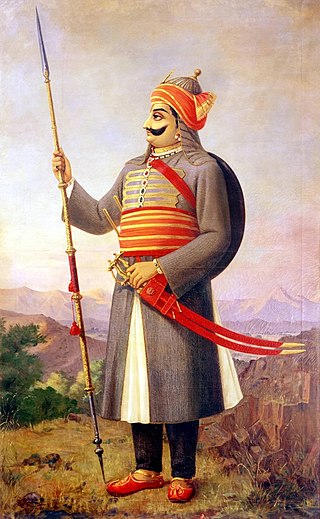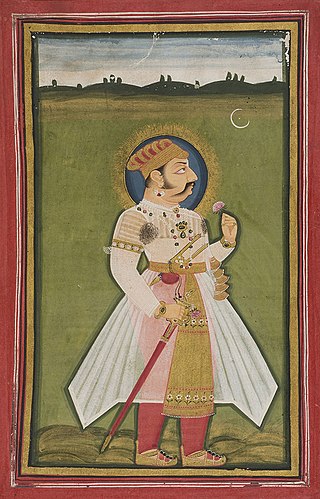
Pratap Singh I, popularly known as Maharana Pratap, was a king of Mewar, a region in north-western India in the present-day state of Rajasthan. He is notable for leading the Rajput resistance against the expansionist policy of the Mughal Emperor Akbar including the Battle of Haldighati and Battle of Dewair which have turned him into a folk hero.

The Sisodia is an Indian Rajput dynasty belonging to the clan that ruled over the Kingdom of Mewar, in the region of Mewar in Rajasthan. The name of the clan is also transliterated as Sesodia, Shishodia, Sishodia, Shishodya, Sisodya, Sisodiya, Sisodia.
Rana Hamir Singh I (1302–1364), or Rana Hamir, was a 14th-century ruler of Mewar in the south and south-eastern RajputanaHamir Singh,was a scion of the cadet branch of the ruling Guhila Dynasty whose title was "Rawal".He regained control of the region, re-established the dynasty after defeating the Tughlaq Dynasty,and captured the former territories of his predecessors from the native governors of Delhi Sultanate and became the first of the "Rana" branch to rule Mewar with title of Maharana. Hammir also became the progenitor of the Sisodia clan, a branch of the Guhila Dynasty,to which every succeeding ruler of Mewar has belonged.

Rao Maldeo Rathore was a king of the Rathore dynasty, who ruled the kingdom of Marwar in present day state of Rajasthan. Maldeo ascended the throne in 1531 CE, inheriting a small ancestral principality of Rathore's but after a long period of military actions against his neighbours, Maldeo swept significant territories which included parts of present day Rajasthan, Haryana, Uttar Pradesh, Gujarat and Sindh. He refused to ally with either the Sur Empire or the Mughal Empire.

Rao JodhaRathore was a Rajput chief of Rathore clan who ruled Mandore in the present-day state of Rajasthan. He was the son of Rao Ranmal. He is known for his illustrious military career and for founding the city of Jodhpur in 1459.

Kumbhkarna Singh, popularly known as Maharana Kumbha, was the Maharana of the Kingdom of Mewar in India. He belonged to the Sisodia clan of Rajputs. It was during his reign that Mewar became one of the most powerful powers in the northern India. He was the most powerful sovereign of his time.

The Chittorgarh, also known as Chittod Fort, is one of the largest living forts in India. It is a UNESCO World Heritage Site. The fort was the capital of Mewar and is located in the present-day city of Chittorgarh. It sprawls over a hill 180 m (590.6 ft) in height spread over an area of 280 ha above the plains of the valley drained by the Berach River. The fort covers 65 historic structures, which include four palaces, 19 large temples, 20 large water bodies, 4 memorials and a few victory towers.

The Battle of Haldighati was a battle fought on 18 June 1576 between the Mewar forces led by Maharana Pratap, and the Mughal forces led by Man Singh I of Amber. The Mughals carried the day after inflicting significant casualties on Mewar forces, although they failed to capture Pratap, who reluctantly retreated persuaded by his fellow commanders.

The history of human settlement in the western Indian state of Rajasthan dates back to about 100,000 years ago. Around 5000 to 2000 BCE many regions of Rajasthan belonged as the site of the Indus Valley Civilization. Kalibangan is the main Indus site of Rajasthan, here fire altars have been discovered, similar to those found at Lothal.

The Kingdom of Mewar, sometimes known as Udaipur State, was an independent kingdom in Rajputana region of India, ruled by the Sisodia dynasty. It was established around the 6th century by the minor rulers of the Nagada-Ahar region of Udaipur and later, in the 10th century, it transformed into an independent state under Rawal Bharttripatta II.
Raimal Singh Sisodia, also known as Rana Raimal, was a Hindu Rajput ruler of Mewar. Maharana Raimal was the son of Rana Kumbha and his Rathore queen, a princess of Idar.
Hindu Rajput kingdoms in the north-western Indian subcontinent resisted the Muslim invasions of India, beginning with the Umayyad campaigns from the Middle East and the Ghaznavid Turks from Central Asia. They continued resistance against subsequent Muslim empires, including the Arabs, Ghaznavids, Ghurids, Delhi Sultans and the Mughals.

Maharana Amar Singh I, the Maharana ruler of Mewar Kingdom, was the eldest son and successor of Maharana Pratap I.He was the 14th Rana of Mewar,ruling from January 19, 1597 till his death on January 26, 1620.
Rana Lakha was the Sisodia Rajput ruler of Mewar Kingdom .He was the son of Rana Kshetra Singh and ruled Mewar from 1382 until his death in 1421.

Mahmud Khalji (1436–69), also known as Mahmud Khilji and Ala-ud-Din Mahmud Shah I, was the Sultan of Malwa, in what is now the state of Madhya Pradesh, India. Khilji came into power after assassinating Mohammad, the son of the previous ruler, Hoshang Shah, in 1435. He mounted an unsuccessful campaign against the Delhi Sultanate however, it was under his reign that the Malwa Sultanate reached its greatest height.
The siege of Chittorgarh took place in 1535, when Sultan Bahadur Shah of Gujarat attacked Chittor Fort, after the death of Rana Sanga, with the aim of expanding his kingdom. The forts defense was led by the Widows of Sanga.
Sauda is a clan of the Charanas. They are also known as Sauda-Barhath. Sauda Charans came to prominence in the kingdom of Mewar with the establishment of Sisodia dynasty in 1326.
The Battle of Mandalgarh took place in 1473. Following an earlier unsuccessful attempt by Ghiyath Shah, the Sultan of Malwa, to capture Chittorgarh from the Kingdom of Mewar, Zafir Khan, one of Ghiyath Shah's generals, led a force which raided and plundered Mewar. In response, a combined force of Rajput armies, assembled by the Maharana of Mewar, met Zafir's army at Mandalgarh; here too, the Malwa forces met with a crushing defeat.

Shahbaz Khan's invasions of Mewar were the ongoing expeditions into Mewar by the Mughal forces of Shahbaz Khan Kamboh. The expansion of the Mughal Empire was initiated during the reign of Akbar the Great. This was notably evident in the Battle of Haldighati, where the Mewar forces suffered a futile defeat, compelling Rana Pratap to retreat to the hills. In the aftermath, multiple expeditions were dispatched to Mewar under the leadership of Shahbaz Khan Kamboh, ultimately leading to the permanent pacification of important territories like Mandalgarh, Kumbhalgarh, Gogunda, and Chittorgarh. These successful conquests culminated in the assimilation of Mewar into the Mughal Empire in 1615.











